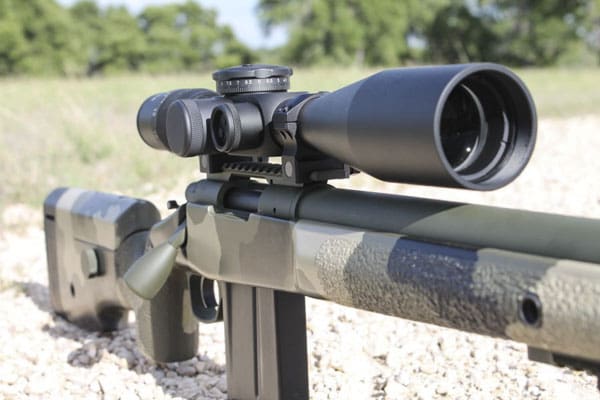
The world of optics is a big one. You can’t throw a stone in an online store without hitting at least forty different types of scopes for your favorite blaster. They range from the cheap and crummy to unholy expensive bespoke models. But as you move up the stack towards stout, bombproof scopes with crystal clear optics and turrets that track well, the field is winnowed quite a bit, and some names start to make more and more frequent appearances.
You know most of them, Leupold, Nightforce, Vortex, Schmidt & Bender, and just Bushnell to name a few. Perhaps a lesser known name, at least to the optic buying public at large, is Brea, California-based U.S. Optics.
USO has been building custom optics for the better part of twenty-five years, but saw that several magnification, reticle, and optical combinations kept recurring which led to their commercial off-the-shelf (COTS) line of optics. When USO originally sent me a scope to review, their lineup included the short range SR line of compact optics, their mid range MR line, the fixed power ST, and the topic of this review, the LR series.
Specifically, the LR-17. Nothing makes you feel more behind the deadline curve than an optics company coming out with a whole new line of scopes between the time they sent you an evaluation sample and the time you actually hit publish. My apologies to the polite Californians at USO.
(Note: the LR-17 has been superseded by the B-17 series. That said, the LR-17 is still available on the market and is fully supported by USO)
The LR-17 is a first focal plane, 3.2-17X scope built for the demands of today’s long range shooter. Fancy more magnification? The BR-25 will give you 5-25X. The LR-17 is geared towards shooters making shots out to 1500 yards who need the ability to make large changes to elevation to compensate for those distances. And that’s probably the easiest way to pick out a USO on the line – the big, fat Erector Repositioning Elevation Knob (EREK) atop the scope body.
A quick primer on long range rifle shooting. The moment the bullet leaves the muzzle, it becomes a slave to the forces of gravity and wind. At relatively close distances (<400 yards), simply holding the reticle off the target can be enough to adjust for those variables. But as the distance increase, more precision is required, and unless you’re using something like a Horus grid, dialing the correction with a turret is really the only way to compensate for bullet drop.
Assuming you have a scope calibrated in milradians (MIL), you’re good with a five mil correction on most short action “long range” cartridges out to about six hundred yards or so. Faster moving, slicker bullets like the 6 mm and 6.5 mm type might require less, but generally speaking, past 750 yards or so, you’ll need to dial more than five mils. I mention this specifically because the turrets on most scopes geared towards this segment use five mils per revolution. Out past that point, you’ll need to make multiple revolutions of the turret.
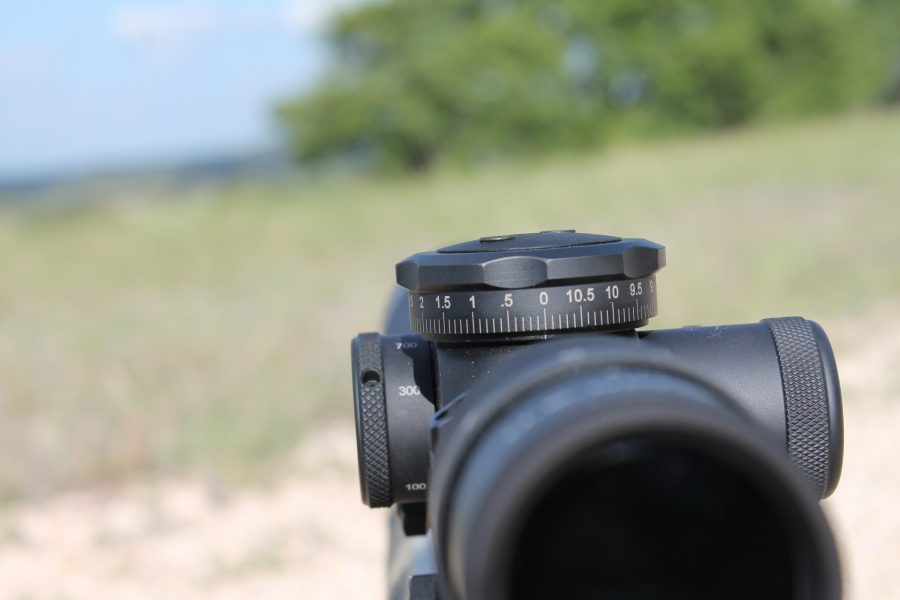
The USO elevation knob is capable of performing eleven mils of correction per revolution. Generally speaking, the fewer revolutions, the better. Taking a look at my ballistic calculator while I pen this, 11 mils is enough to get a moderately charged 6.5 mm 140 gr. A-MAX out to about 1125 yards. Slower, heavier .308’s and such will be a bit closer in, but 11 mils seems to be the “magic” correction to get almost anything past the 1000 yard line. Another revolution of the turret is more than enough to get most everything out to the stated 1500 yards the LR-17 is designed for. The LR-17 that USO sent me is capable of 24 mils of travel in total. Two full revolutions and then some. But the EREK knob has another trick up its sleeve.
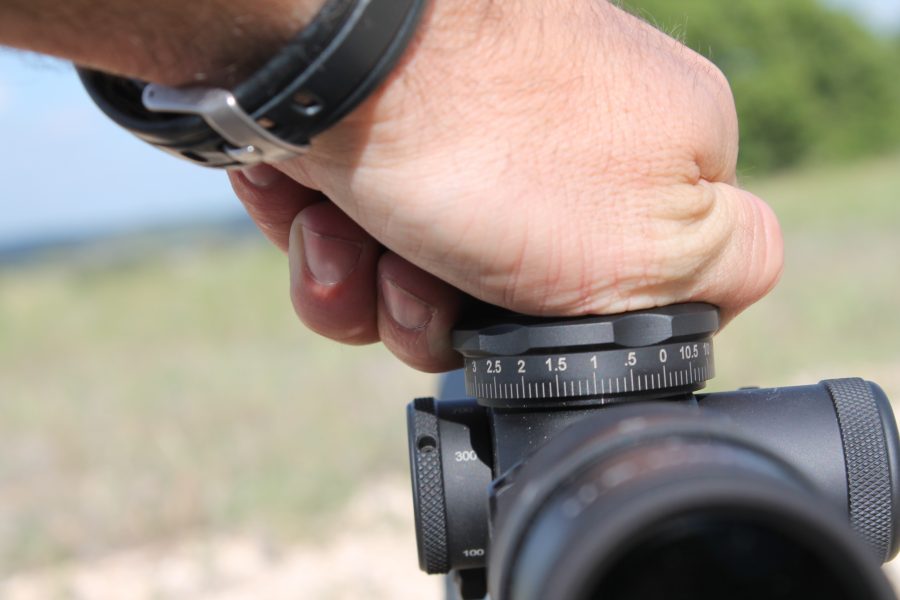
In the linked instruction manual is a rather innocuous mention – EREK Knob: The Erector Repositioning Elevation Knob (EREK) incorporates a center screw for rough zeroing. This allows the knob to be zeroed near the bottom of its travel so that all movement of the knob is upward.
One of the reasons that shooters are attracted to the USO line of scopes is the ability to adjust the reticle independently of the elevation knob using an internal hex key adjustment. Doing so allows you to maximize the elevation travel such that your 100 yard zero is near the very bottom of the elevation knob travel. Paired up with a 20 MOA base, you can truly stretch the legs of your cartridge.
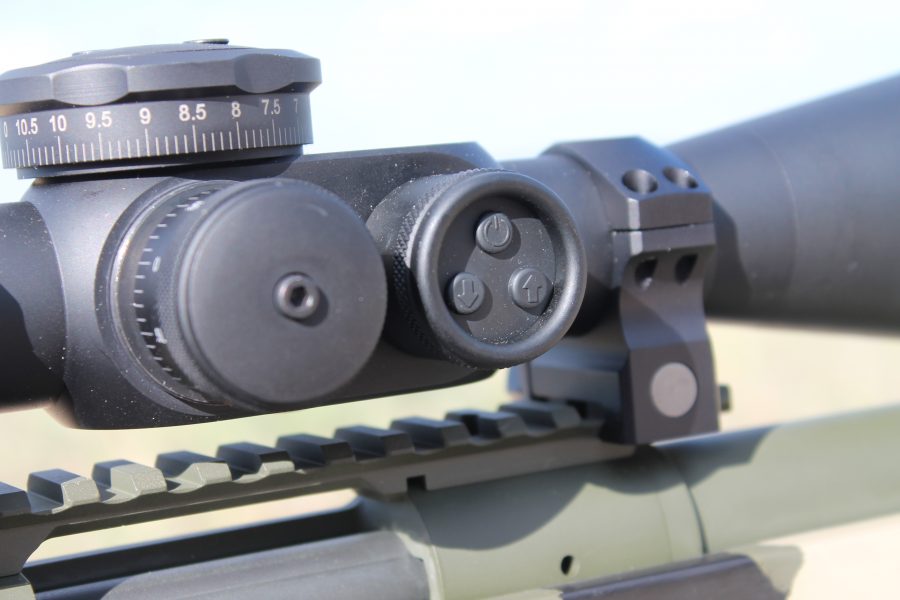
In practice, this process requires some range time, trial and error, and if you’re me, the purchase of a magnetic boresighter. The process is fairly straightforward, and the manual does a good job of laying it out for the end user. First, zero the rifle using the turrets, stick the boresighter to the muzzle (with the rifle unloaded of course!), and take note of the orientation of the crosshairs. Run the elevation knob to the bottom of its travel, and adjust the reticle back to the original point of aim using the included hex key. Shoot another three shot group to confirm the setting and make any fine adjustments with the turret. With everything set, replace the top cap and consider yourself locked in.
Alternatively, you could zero the rifle, lock it in a vise of some sort while aimed at your 100 yard target, and make the same set of corrections. The unfortunate fact of the matter is that the amount you can change the point of impact during this process is substantial. I failed to write the exact value down, but I ended up moving the reticle close to 7 mils during my zeroing process which translates to ~25 inches at 100 yards. That’s enough to clear a berm or send one into the floor if you aren’t careful, so I would recommend buying the magnetic boresighter – it’s a tool you’ll end up using more than you think.
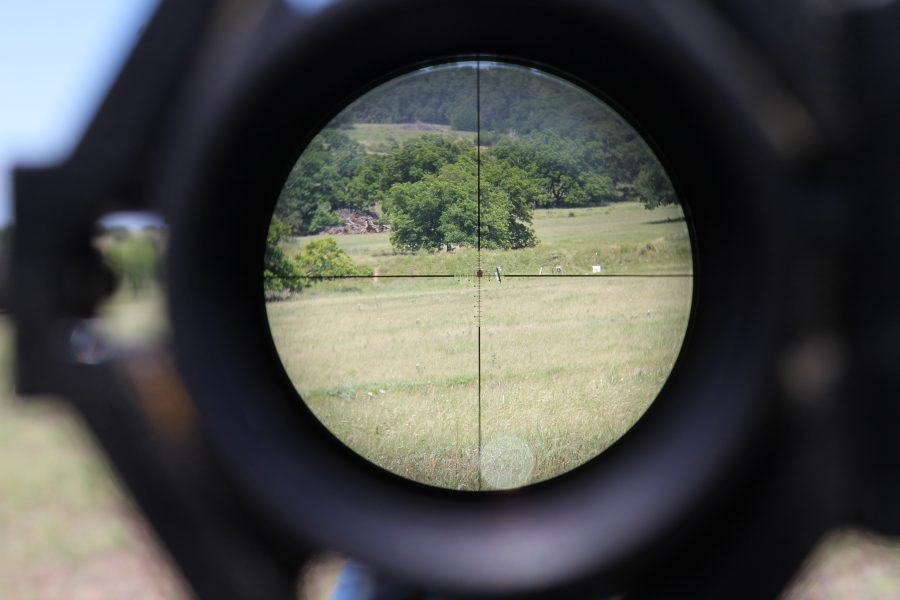
Once zeroed, the time comes to start looking at stuff thats far away. The optical quality on the LR-17 is nothing short of impressive. Only because I had a Nightforce scope on hand was I able to judge the Nightforce glass a touch clearer at full power. Otherwise, great glass with excellent light transmission. At the lowest magnification, the field of view is large and richly colored. There’s zero difference between looking through your own eyes, and looking at a target half a mile away with the exception of the magnification level. Above is an IPSC torso painted orange and black and 475 yards. As you can see, the image is clear from edge to edge with no blurring or distortion at the edges. As is the case with first focal plane scopes, the reticle is very thin at this power, to the point of being essentially a fine duplex type.
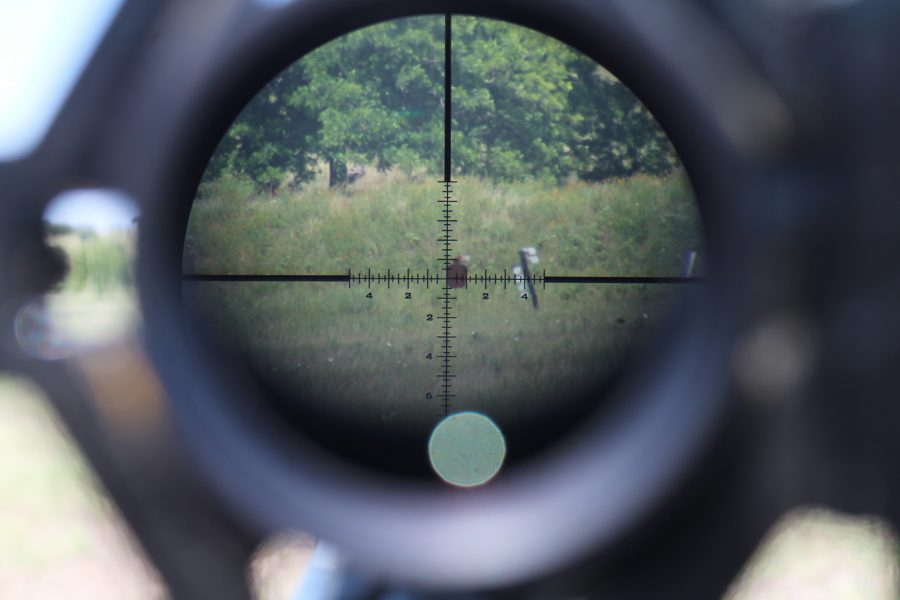
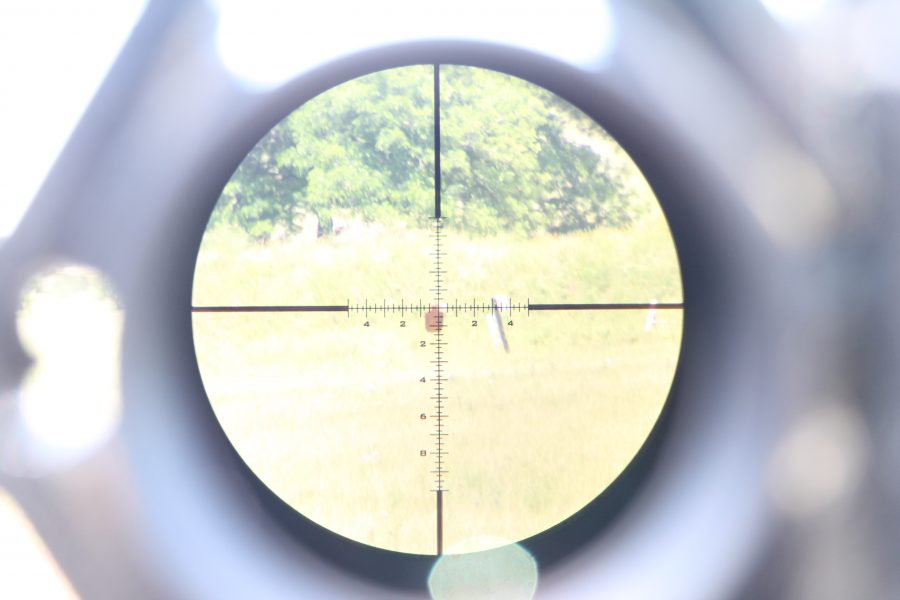
Gripping the finely knurled magnification knob and giving it a twist to the highest power yields a much larger image that is still quite crisp once you’ve adjusted for parallax to bring the image and reticle into focus. This is accomplished with a large diameter, but very slim knob on the left hand side of the scope. As always, my picture taking skills are left wanting. Rest assured that the washed out and/or darkly colored images you see above are not representative of the clarity and fidelity I saw at the quarter mile line and beyond.
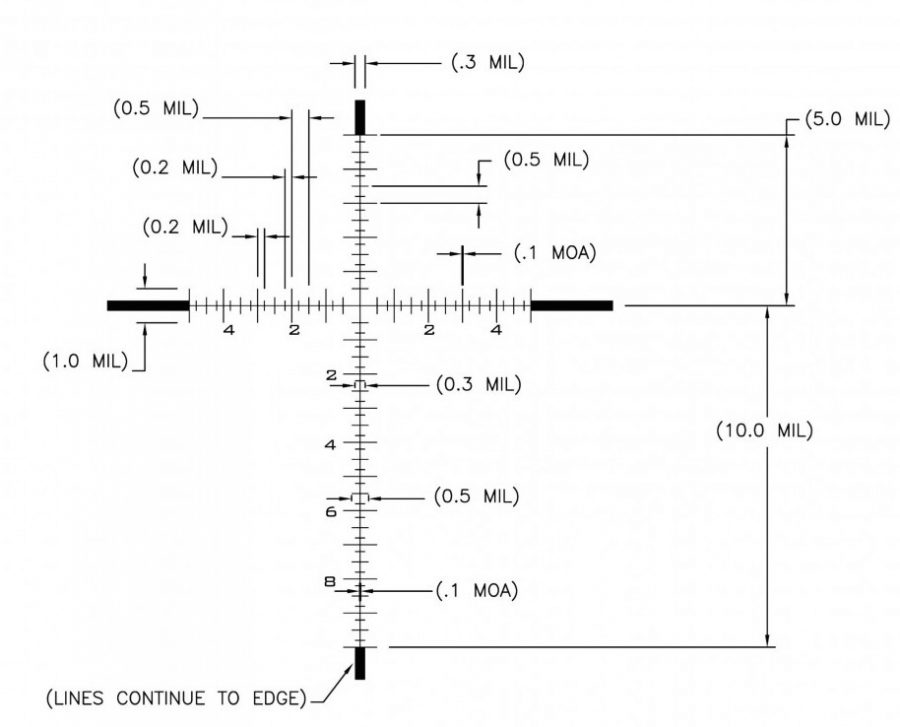
As USO offers at least twelve reticle choices for the LR-17, you have options if you’re considering this model. That said, I had to pick one, and I was immediately intrigued by the Mil Scale MPR. Most shooters who have spent time behind a reticle with hash marks of some sort are used to something with half mil divisions. The Bushnell DMR that has become my go to beat around scope for testing rifles uses a simple reticle that has half mil divisions out to eight mils in every direction. I like it quite a bit as it is (mostly) idiot proof, and does a pretty good job with reticle based ranging.
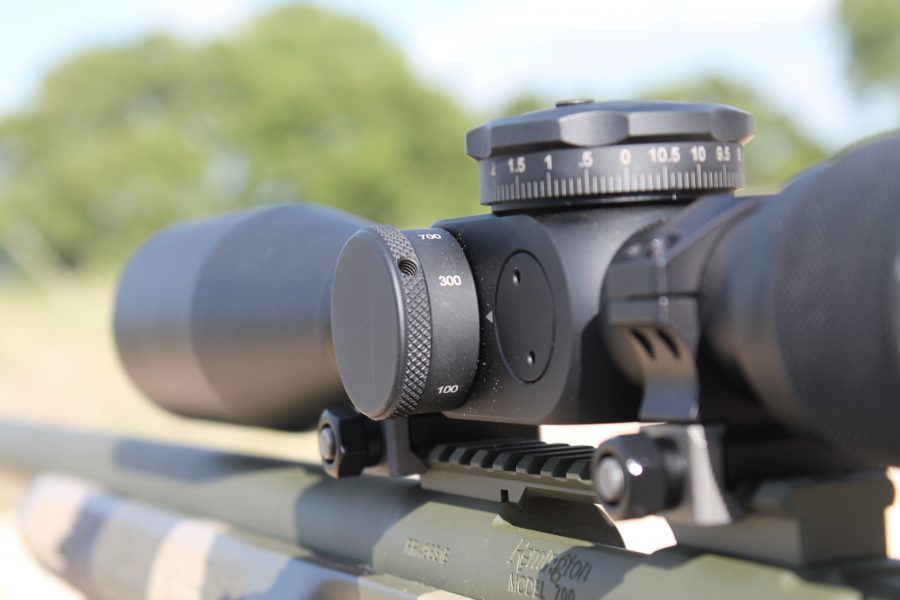
Where the Mil Scale MPR impresses (in theory) is that it splits the half mil divisions up into 2/10 and 3/10 mil divisions. Starting at the center of the crosshairs and moving to the right along the horizontal line, the first hash mark is .5 mils from the center. The next line is .3 mils further, or .8 mils in total from the center. The third has is 1 mil, and the next one is 1.2 mils. So on and so forth with the whole number hash marks being bracketed on either side by minor hash marks set .2 mils away. The same subtension scheme translates to the vertical axis as well.
This has the very real benefit of allowing the shooter to measure known sized targets to calculate distance. Of course, that’s true of any graduated reticle, but in this case, it allows for a much finer measurement. With the Mil Scale MPR reticle, the shooter can accurately measure anything down to a 1/10 mil with ease. I’ve put together a small table below to show the various combinations that correspond to various subtensions.
- .2 – second hash to third hash
- .3 – first has to second hash
- .4 – second to fourth hash
- .5 – center to first hash
- .6 – fourth to sixth hash
- .7 – second to fifth hash
- .8 – center to second hash
- .9 – none
- 1 – center to third hash
- 1.1 – – none
- 1.2 – center to fourth hash
- 1.3 – first to sixth hash
- 1.4 – second to eighth hash
- 1.5 – center to fifth hash
It certainly takes some time to learn, but once you get it down, it becomes as easy as the multiplication tables you learned back in your single digit years. Your first conclusion might be that it’s a “busy” reticle, but I didn’t find that to be the case at all. The minor subtensions are small enough that the half mil increments still stand out, and for quick shooting where bracketing the target is really all you need, I found it to be just as fast as a traditional hash marked reticle. Slow it down, and you can carefully take measurements and hold off for wind or elevation by a very precise amount.
In a practical scenario, I found the MPR to be very handy at ATX Precision’s PR1 class where I got the opportunity to engage a moving target at distances from 400 to 800 yards. My Kestrel is happy enough to compute a hold for moving targets, in this case .39 mils, but using the MPR reticle I was able to precisely check the computer’s math and start registering hits at a variety of distances.
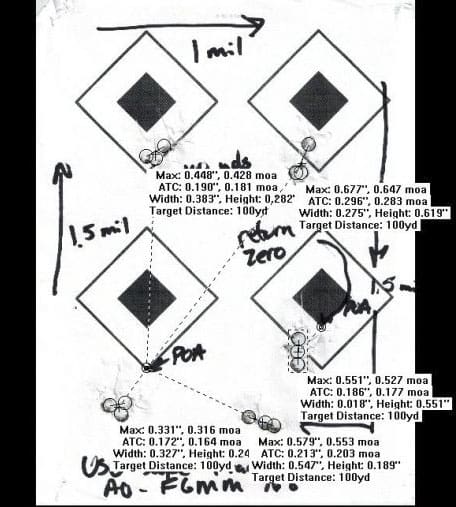
Now for my favorite part – science! Testing this scope was the inaugural use of my glorified lab equipment rifle from Accurate Ordnance. I started by testing the turret tracking using a box test. Shooting Federal Gold Medal 168 gr SMKs at a laser ranged 100 yards on a calm day, I zeroed the USO to hit a touch low and left of my point of aim, and fired three shots. Those are the three on the lower left hand corner. I then adjusted the elevation knob up 1.5 mils, took three more shots, and proceeded to work my way around the target. My point of aim never changed. Once I was done, I returned the scope to zero, and moved my point of aim to the bottom of the dark diamond on the bottom right hand side, and fired three more shots. Once I returned from the range, I scanned my target and plugged it into OnTarget.
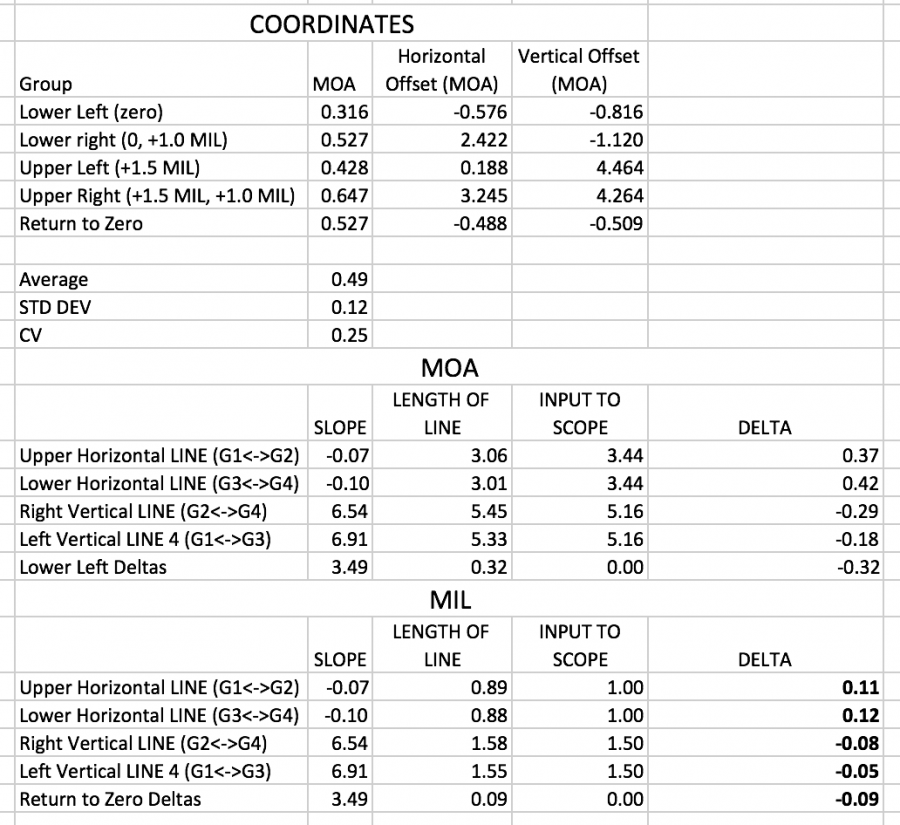
The first order of business was setting coordinates for the center of each shot group off the reference point of the bottom of the lower left diamond. The fifth group, identified as “Return to Zero” is the last group I fired after returning the turrets to zero. With the coordinates set, I computed the average group size (.49 MOA), and Standard Deviation (.12).
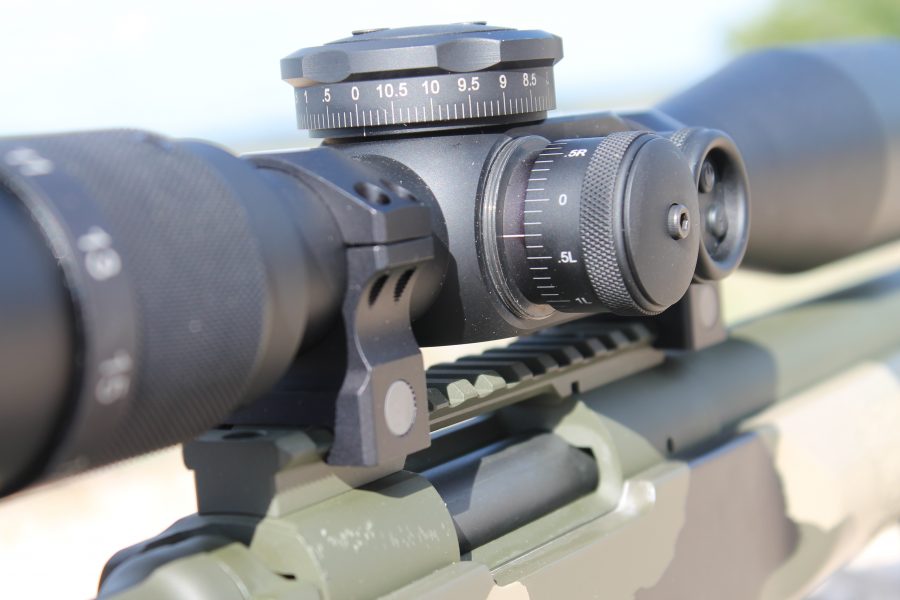
Since OnTarget does everything in minutes of angle (MOA), I had to do all my calculations in MOA and then convert them to mils. Using the pythagorean theorem, I was able to calculate the distance between each coordinate group, and just for giggles, I calculated the slope of the line. As you might guess, a “square” box is best. The target looks askew because the target was off kilter stapled to some plywood leaning against two fence posts.
Converting to mils, I was finally able to compare my input to my results. The distance between the upper groups, and lower groups, identified as horizontal lines were .11, and .12 mils shorter than my input of 1 mil. However, it is important to keep in mind that the standard deviation I saw in my groups for this test were .12. So any difference I measured fell within one standard deviation.
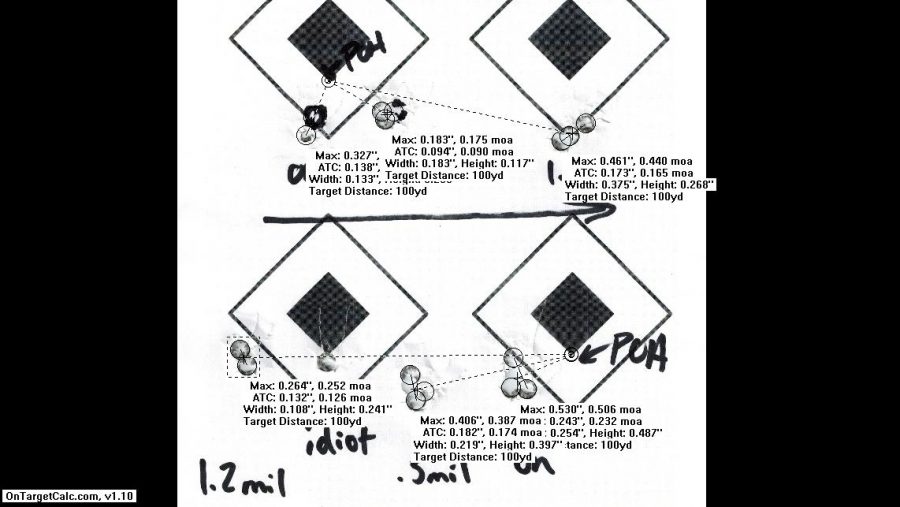
As this reticle is designed for the shooter who desires a “dial for elevation/hold for wind” setup, I felt it necessary to test the reticle subtensions for accuracy as well. Above is the target I used to test the .5 mil, and 1.2 hold offs on either side of the crosshairs.
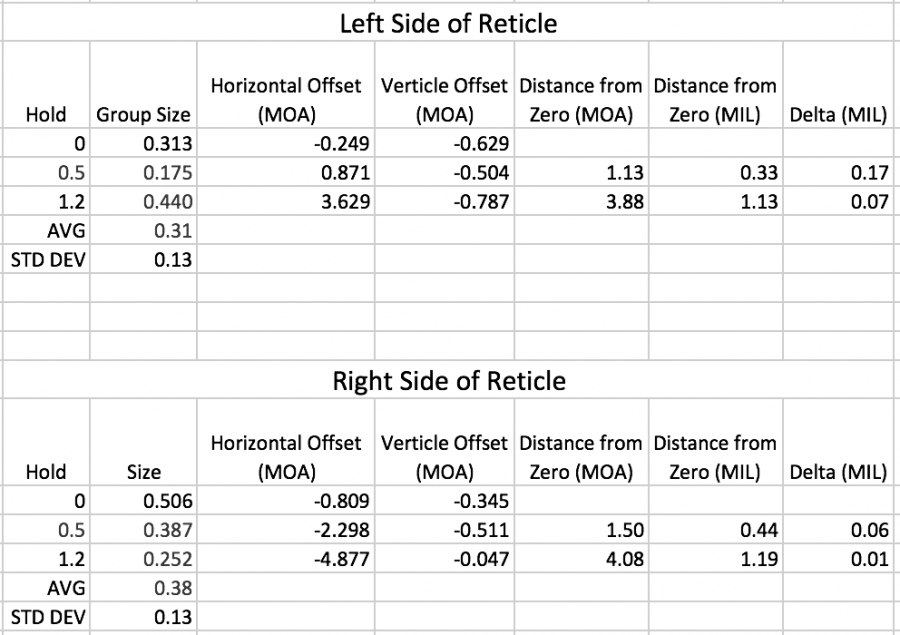
With such a small sample size, standard deviation numbers are bordering on meaningless, but like I saw with the scope tracking test, all of the numbers fell well within one standard deviation with the exception of the half mil hash on the left side of the reticle. I blame the shooter as they’re both quite even when looking through the scope.
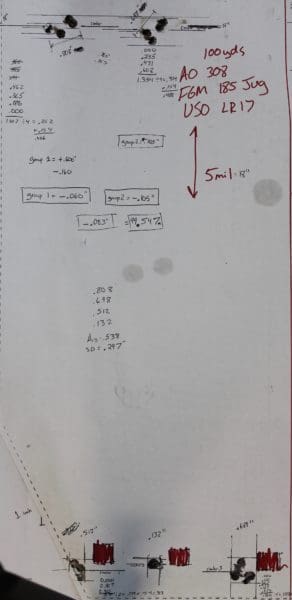
The last test I performed after I’d had the LR-17 in place for quite some time. I had gotten into a particular fit of buttonology and had a theory that scope tracking error might be a “hidden” cause for ballistic truing errors. Given that the USO LR-17 seemed fairly dead on in a small scale box test, I wanted to test it out over a larger elevation range at the 100 yard line. I enlisted the help of an Action Target Cardboard IPSC target and some Federal Gold Medal 185 Juggernaut loads to see how the USO did over a five mil adjustment range. My target is above.
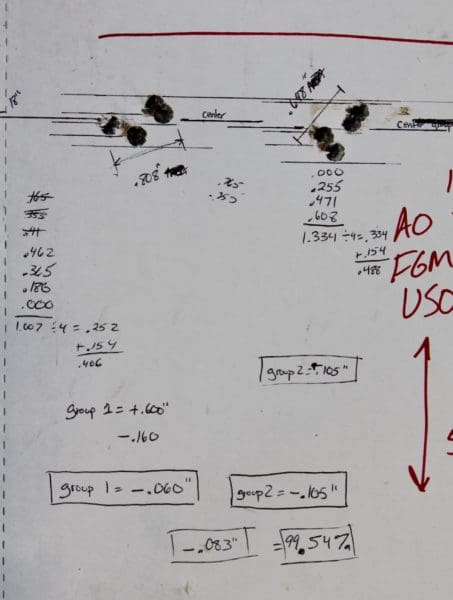
A bunch of groups later, and I found that the LR-17 was off by less than a tenth of an inch over 18 inches of travel leading to a “truing” value of 99.54%. That’s well within my capabilities as a shooter, and something I have complete faith in.
Nearly a year of testing, and something like a thousand rounds later, and I’m more familiar than I’d originally planned on being with the U.S. Optics LR-17. Overall, I think it meets the expectations I’d put forth for a $2000+ optic. The EREK knob is interesting to use, and while a bit laborious to set up (fixed in the new B series), it does allow a great deal of elevation travel – excellent for those long range shots.

As it plays in the same sandbox as the ATACR from Nightforce, I’m forced to draw a comparison. Having shot both models back to back on the exact same day, I have to tell you that the Nightforce glass is a touch clearer with a bit more depth and richness than what USO brings to the table. The difference is minute and one I was only able to spot shooting both back to back, but it’s there. I think the most telling place where I had issues was with similarly colored targets and backgrounds, a shot up steel target against an earthen berm, where the USO couldn’t bring the image clarity I’d get from a comparable Nightforce.
The other gripe I had was with the MPR reticle itself. USO says the main crosshairs are .1 MOA/.034 mils thick which sounds really tiny, but in reality is just a touch thick. Thick enough that I’m inclined to call BS on USO’s stated numbers. I found this to be especially frustrating at the aforementioned PR1 class at ATX Precision. The reticle was just too thick to get a clear view of the paddle coming across on the mover. I kept losing it in the line of the reticle. Eventually, I resorted to dialing a bit of extra elevation, holding low, and bracketing the moving paddle in the open space between vertical subtensions. Again, it is a very minor gripe, and one that only reared its ugly head in a very specific scenario, but at this price level, every nit is worth picking.

Specifications: U.S. Optics LR-17
- Weight 3.13 lbs
- Dimensions 15 x 3 x 3 in
- Magnification : 3.2-17x
- Length: 16.50 in
- Eye Relief : 3.5 in
- Reticles: Many – all illuminated
- System: Mil or MOA
- Price: $2100+ depending on options
Ratings (out of five stars):
Fit, Finish, Build Quality * * * * *
The LR-17 took some tumbles while in my care and came out unscathed. Somewhere, there’s a video of a U.S. Optics employee repeatedly throwing one of their scopes into the pavement outside HQ and then strapping it back on a rig for a turret tracking test (which it passed). Like any of the well known $2000+ riflescopes, you can expect that it will be built for the end times.
Image Quality * * * *
It’s good. Very good. Is it the best? No. In fact, Cal at PRB.com did a test a few years ago that found the USO scope he tested to be in the middle of the pack for optical clarity. Good, but not excellent. You can really only tell when you line the LR-17 up against some other high end glass. Otherwise, shoot it and love it.
Tracking * * * * *
I must have formally tested this one category a couple dozen times and every time it came out unscathed on the other side. At less than one tenth of an inch of error over eighteen inches of travel, it’s a safer bet that shots hitting high or low are the shooter’s fault.
Reticle * * *
The concept of the MPR is flawless. It might seem gimmicky or busy at the outset, but I found it to be unobtrusive in “fast” shooting situations and appropriately useful when there was time to really slow down and set up the shot. That said, it could stand to be a few percentage points thinner so as to obscure less of the target.
Overall Rating * * * *
With the B series scopes in the $2500+ range, the LR-17 represents an opportunity to own last year’s model at a bit of a discount. You very well might find one in the used market, punted in favor of a new, shinier thing. If you could find a sub $2000 example, you’d be getting quite a bit of bang for your buck. Given the durability and accuracy I saw on display, this is a scope that will be in useful service for a long time, but if you can convince someone else to get rid of theirs for a song, you’re money ahead. The optics are *just barely* not as a clear as a similarly priced Nightforce, and the EREK knob can be a bit of a pill to set up, but it’s a fine scope, and one that seems to fit in well with similarly priced optics.




Thank you. Good write up. Thanks for all of that, no potato needed. : )
Agree with your comparison’s. Liked the larger turret knobs, period, but really like the apparent functionality.
Glad to see someone else is a fan of Cal at PRB.com. 😉
I used to be a avid fan of USO, visiting their local shop many times and owning several of their scopes. They make great products without a doubt. But their price point (like NF and S&B) have been lacking IMHO. Vortex has really stepped up to the game in the past few years. They (Vortex) has a presence at (LR, PRS, etc.) events that no other manufacturer makes the effort to attend, this crucial feedback is necessary to succeed in the optics industry.
Thanks for the review.
Without a doubt, Cal is providing some of the best information on the internet about precision rifle shooting. Absolutely one of my favorite writers.
Next spare $2100 I have I’m gonna buy me one of these.
Excellent write up. Do you think it’s possible to still make hits out to 1000 without the use of a 20moa or otherwise canted base ,such as on an ar-10 (6.5 creedmore) with the LR-17? I ask only because it’s quite hard to find a one piece mount with 20moa that fits the USO’s close turret design.
Comments are closed.